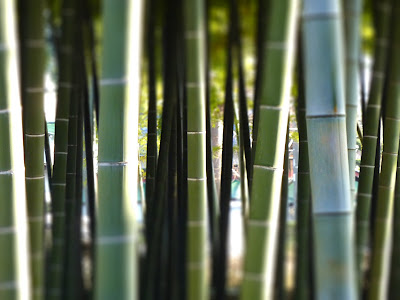Normality is still trying to return. I mean sure, everyone is worried about the radiation - I probably glow in the dark now during my self-imposed nightly blackouts. But the city is going about it's business, just at a less hectic pace. So while there is stuff going on, the streets are way emptier than they would usually be.
It's not all bad having fewer people out and about. For one thing, it's easier to get a table at restaurants, especially the really popular ones that would usually have queues out the door. In light of this, I started my weekend with breakfast at a nice French brasserie. You can say a lot about the French, both good and bad, but they sure know their baked goods. If you're in
Tokyo and you're looking for an authentic Gallic experience (minus the odorous waiters) Aux Bacchanales in Ginza comes recommended by me... Best pain au chocolat to be had over here.
The rest of my Saturday was given over to Nezu Bijutsukan in Aoyama. This is a small private museum in the heart of city that was refurbished a couple of years ago. It was rebuilt in a kind of zen modernist style. Here is the subdued but chic entrance.

The museum is most well known for its Chinese bronzes. I really liked this one. It would be have used to hold wine offerings to the sheep god.

The latest special exhibition was one of bronze mirrors. The poster had a tag-line along the lines of "come see the reflection of 1,500 years ago". I liked that, that somehow the images of the faces that used these bronze plates all those hundreds of years ago were somehow left on the surface. Of course, I felt it was a bit of a cheek when 79 of the 80 mirrors were laid face down - it's the decorative engravings in the backs of the mirrors that collectors really prize. Only one piece was set up face out and burnished to it's original glory. It was impressive what a good reflection you could get out of a piece of bronze; kind too, as it nicely softened out the wrinkles and gray hairs.
The other thing that caught my eye was a display of 買い合わせ (kaiawase). This is a game dating back more than 1,000 years to the Japanese Heian period where you lay out decorated clam shells face down and make matching pairs, kind of like memory.

This was such a popular game with young girls of the period that a set was often gifted to them upon marriage. According to the exhibitors, this led to a woman's 'kaiawase' becoming synonymous with her virtue - the Heian Period was a time of courtly refinement with a lascivious underbelly of noble men and women sneaking out in the dead night to meet their lovers. The bit of history gave a new depth of meaning to the 'clam shucking' euphemism so popular with my friends in Luxembourg.
But the best part about the Nezu museum is its gardens. You could almost forget that you are in the city. Stone pathways lined with moss-covered statues and lanterns twist between ponds and pagodas and small tea rooms.

It is very peaceful.


I felt this little
Buddha. Happy to be alive, yet wary of becoming too attached. Alive in the moment and trying not to count on more.

The magnolias and even some early cherry tress were in bloom. Life goes on.





























